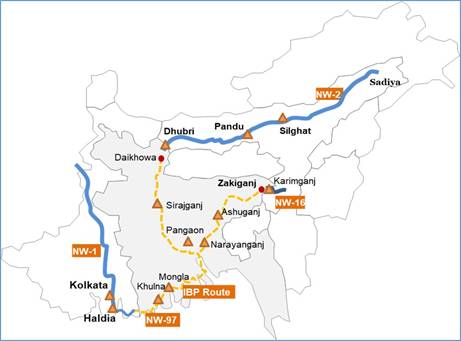Syllabus: GS-III: Infrastructure
Why in the news
India is repositioning the Northeast as a river-powered growth engine. Ahead of India Maritime Week 2025 (27–31 Oct, Mumbai), a suite of Inland Water Transport (IWT) projects on the Brahmaputra (NW-2), Barak (NW-16) and newly operational stretches of Dhansiri (NW-31) and Kopili (NW-57) has moved from concept to execution: fairway maintenance, modern terminals, IBP (Indo-Bangladesh Protocol) route integration, and cruise/urban ferry plans. The thrust aligns with Viksit Bharat and the Panchamrit climate framework—seeking logistics that are cheaper, cleaner, and more inclusive.
India Maritime Week 2025 — At a Glance
|
Northeast’s rivers: from heritage to hard infrastructure
- Civilisational continuity: Rivers were the original highways of the region—used by the Ahoms for trade, troop movement and diplomacy; expanded by the British for colonial commerce.
- Policy pivot since 2014: Under the leadership of the Prime Minister, rivers are being reimagined as economic arteries—a sustainable, multimodal complement to road and rail.
- Statutory backing: The National Waterways Act, 2016 notified ~20 waterways in the Northeast; key corridors now see structured investment and operations.
What’s on the water: status, assets, and cargo
1) NW-2: Brahmaputra (Sadiya–Dhubri, ~891 km)
- Fairway & aids: Systematic dredging, hydrography and night navigation aids.
- Terminals: RCC jetties at Pandu, Dhubri, Jogighopa, Bogibeel; floating jetties at key nodes.
- Multimodal links: Integration with road/rail underway; Pandu–NH-27 dedicated link nearing completion.
2) NW-16: Barak & IBP routes
- Terminals: Badarpur, Karimganj (Assam); Sonamura (Tripura) upgraded/operational; Maia terminal functional.
- Cross-border trade: Direct access to Bangladesh and the Bay of Bengal via Brahmaputra–Barak–Sundarbans, bypassing the Siliguri Corridor.
3) Newer stretches & trials
- NW-57 (Kopili): Trial moved ~300 MT cement (Chandrapur → South Salmara)—a template for interior, last-mile supply chains.
- Throughput: ~1.1 million tonnes/year of bulk (stone chips, coal, lime, cement) already moving on Brahmaputra/Barak/IBP.
4) Tourism & urban mobility
- Cruise circuits: New terminals at Silghat, Biswanath Ghat, Guijan, Neamati, Uzan Bazar to position the Brahmaputra as a global river-tourism destination.
- Urban Water Transport (UWT): Ferries planned/expanded in Guwahati, Tezpur, Dibrugarh to decongest roads and cut emissions.
5) Community & maintenance ecosystem
- 85 community jetties across the Northeast—lifelines for local trade and passenger movement.
- Ship repair facility at Pandu: Regional hub to reduce downtime, create skilled jobs, and anchor private services.
Pipeline of new corridors
- Mizoram: Tlawng, Chhimtuipui; Khawthlangtuipui–Tuichawng corridor.
- Nagaland: Doyang Lake (IWT); Noune & Shilloi Lakes (water sports/tourism).
- Tripura: Gomti–Meghna linkage with Bangladesh (fairway, bank protection, nine floating terminals, nav-aids; hybrid vessels at Dumbur Lake).
- Manipur: Barak and tributaries Imphal, Nambul.
- Meghalaya: Umiam, Umngot (NW-106) under IWT evaluation.
- Arunachal Pradesh: Siang study included.
Together: A connected Eastern Waterways Connectivity Network.
| Numbers of National Waterways of Assam Within Assam
Assam With Other State
|
Why waterways change the economics
- Low cost, low carbon: Per tonne-km, IWT uses a fraction of road fuel and emits far fewer GHGs—ideal for bulk logistics and climate goals.
- De-risking geography: IBP corridors reduce dependence on the Siliguri bottleneck, improving supply chain reliability.
- Inclusion: Ferries/ro-pax services integrate chars and island communities into mainstream markets and services.
- Tourism multiplier: River cruises, nature/culture circuits (e.g., Kaziranga–Majuli) create local jobs with relatively lower ecological footprints.
The challenge ledger
- Hydrology & seasonality: Monsoon floods/siltation vs lean-season depths—demands adaptive fairway management.
- Hinterland gaps: Last-mile road/rail to terminals can erode IWT’s cost advantage if delayed.
- Institutional complexity: IWAI, state IWT departments, customs, environment clearances—need single-window facilitation.
- Environment & social safeguards: Dredging/bank works must avoid dolphin habitats, fish spawning grounds, erosion-prone chars; cumulative EIAs over project-by-project clearances.
- Safety & skill: Reliable charts, RIS/VTS, certified crews, and emergency response are essential for scaling.
- Early-stage viability: Low initial volumes deter private investors without PPP risk-sharing and stable tariff regimes.
Way forward
- Assured Depth Contracts: Performance-based O&M for Minimum Assured Depth (MAD); publish real-time depth dashboards.
- Hydro-sediment science: Sediment budgeting, seasonal channel alignment, low-impact river training; integrate hydrology with dam/embankment ops.
- Terminal–Hinterland Integration: Time-bound completion of terminal links (e.g., Pandu–NH-27), ICDs and freight streets; 24×7 clearances.
- PPP with VGF: Standard concession templates for terminals, warehouses, cold-chains, and ship repair; targeted viability gap funding.
- Containerization & IBP: Promote river containers, simplify transshipment/documentation, expand ports of call with Bangladesh; align with BBIN flows.
- Community Jetties 2.0: Fast-track 85 jetties with SHG/FPO participation; digital ticketing, sanitation, and safety norms.
- Green IWT: Incentivize hybrid/electric/hydrogen-ready ferries; shore power; dolphin-safe speeds and routeing.
- Cruise/UWT Code: Unified safety/service standards, carrying-capacity caps, night-navigation protocols, and local livelihood linkages.
- Skills & Standards: Northeast IWT skilling hubs for pilots/engineers/hospitality; enforce vessel standards (hull, stability, safety).
- Digital River: Expand e-navigation, AIS, VTS/RIS, and forecast systems; integrate with Gati Shakti logistics map.
- Outcome KPIs: Track tonnage moved, cost/tonne-km, GHG saved, accidents/MMT, tourist footfall, jobs created; publish an annual Northeast IWT Report Card.
- Institutional Convergence: IWAI–States–Customs–Immigration–Tourism single-window cells at key terminals (Pandu, Dhubri, Karimganj, Badarpur).
Conclusion
The Northeast’s destiny need not be confined by mountains and monsoon alone. Rivers—fluid, resilient, timeless—are once again its lifelines. With assured depths, multimodal links, community jetties, and green vessels, waterways can lower logistics costs, cut emissions, deepen cross-border trade, and knit remote communities into opportunity circuits. Each dredged channel, each terminal, each ferry route brings Viksit Bharat closer—by rewriting India’s connectivity in the language of rivers.
Mains Practice Question
“Waterways are not just cheaper and cleaner; they are strategic for the Northeast’s integration with national and regional markets.” Discuss with reference to National Waterways 2 & 16, the IBP route, and recent infrastructure initiatives.SOURCE
Start Yours at Ajmal IAS – with Mentorship StrategyDisciplineClarityResults that Drives Success
Your dream deserves this moment — begin it here.




